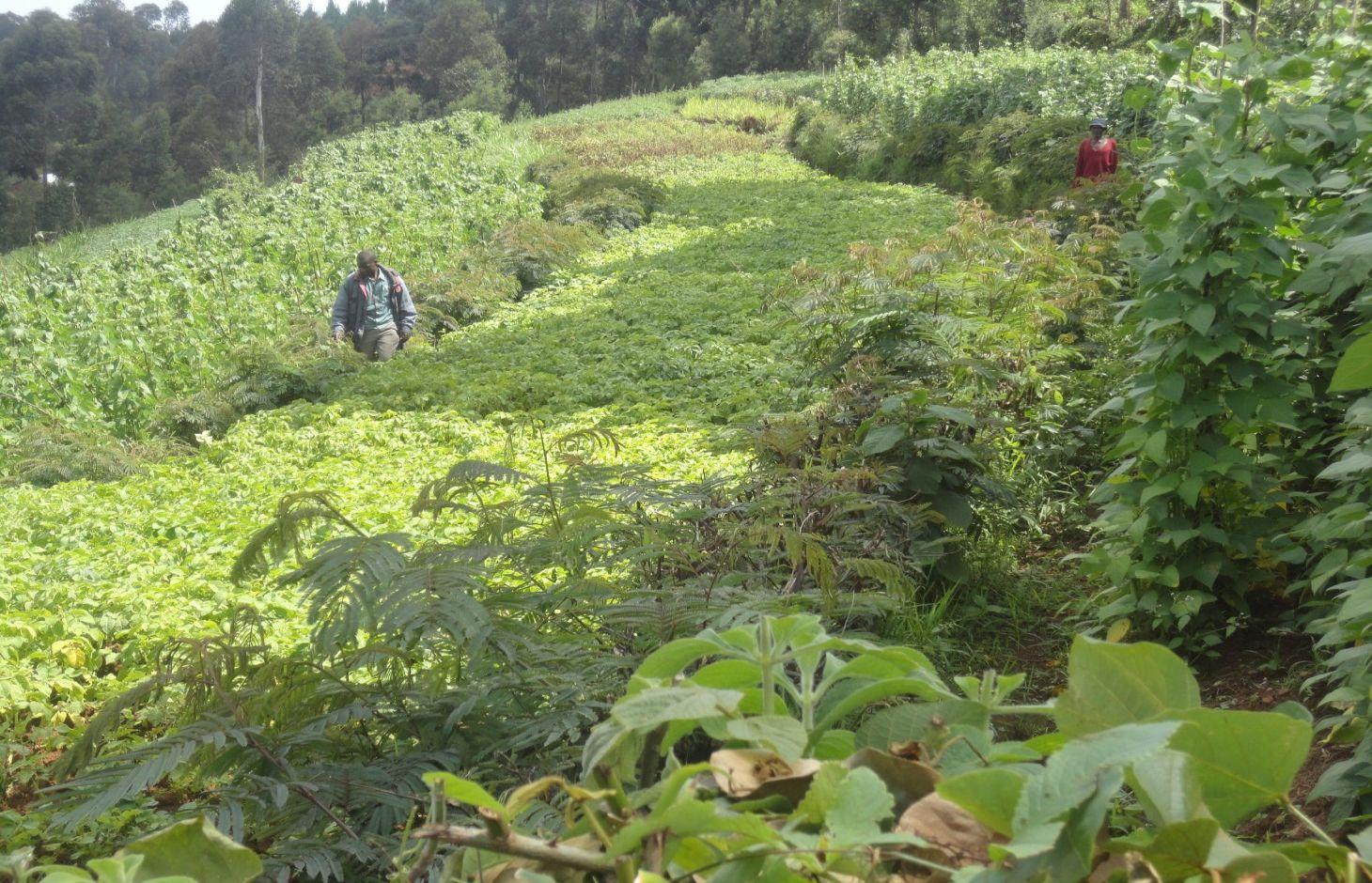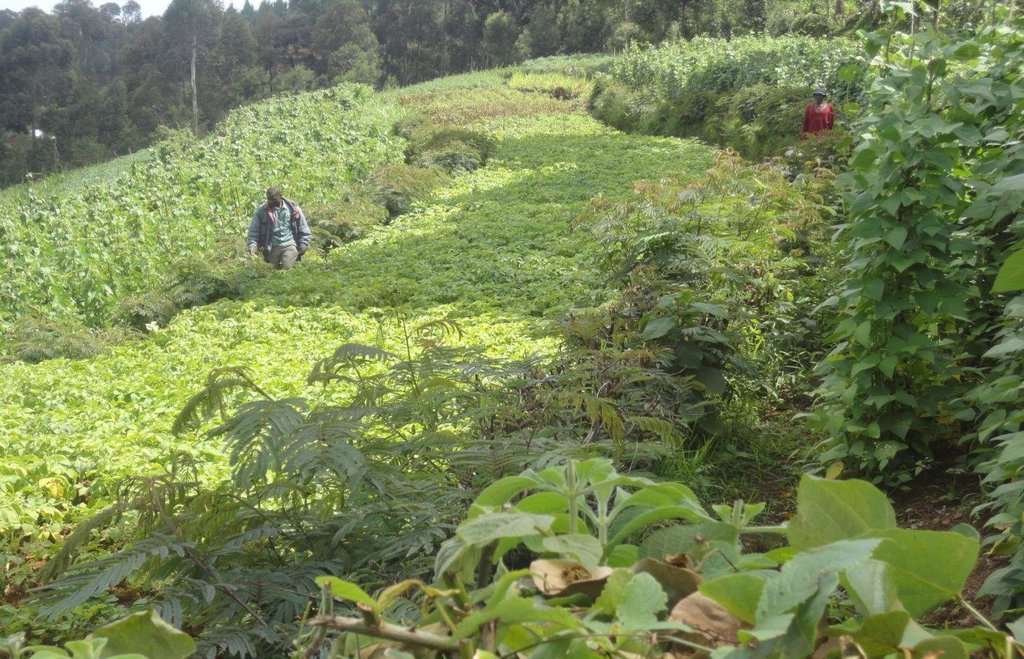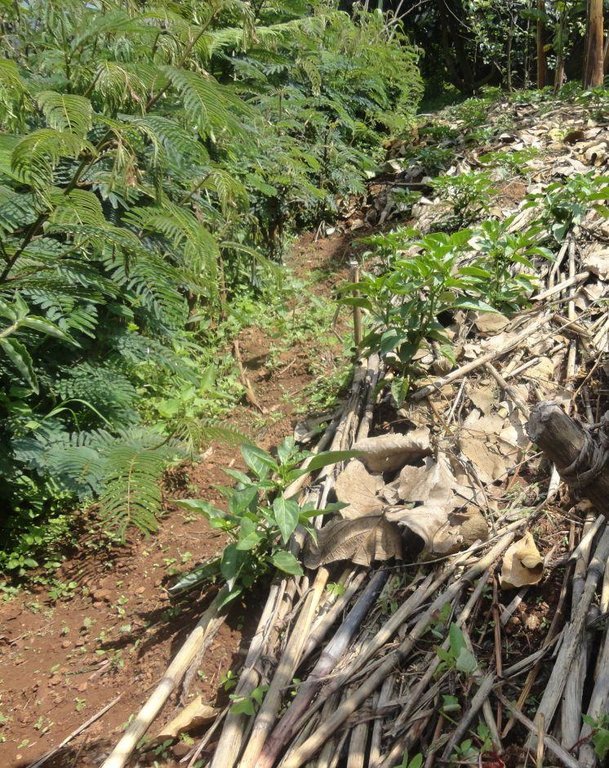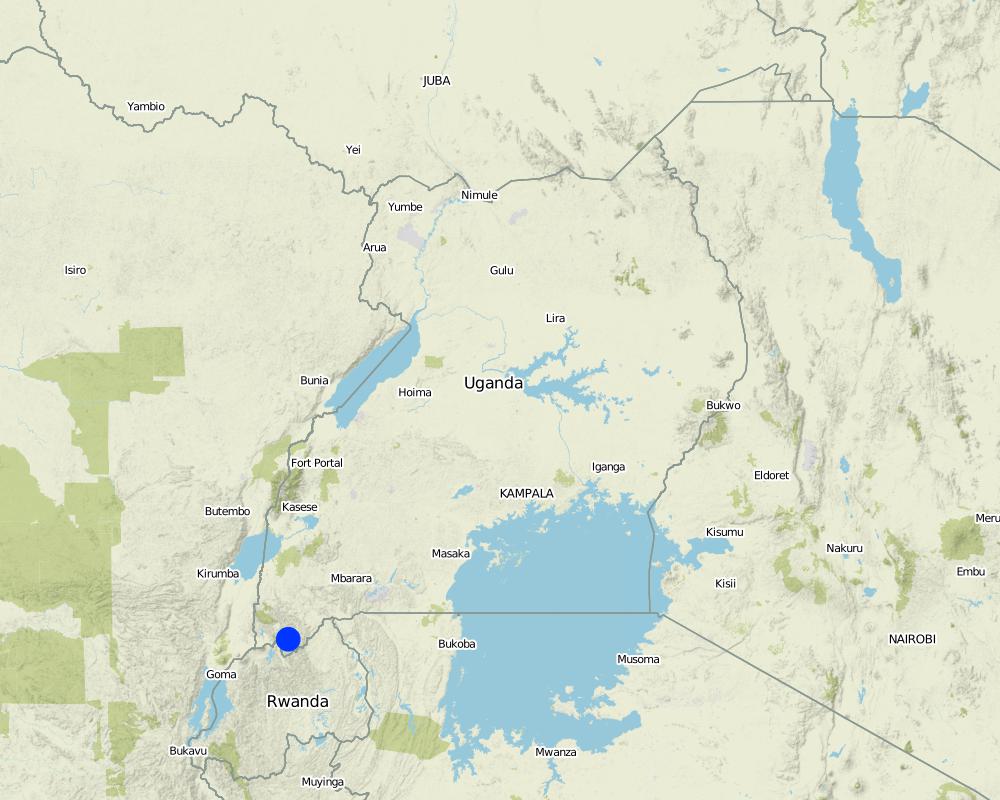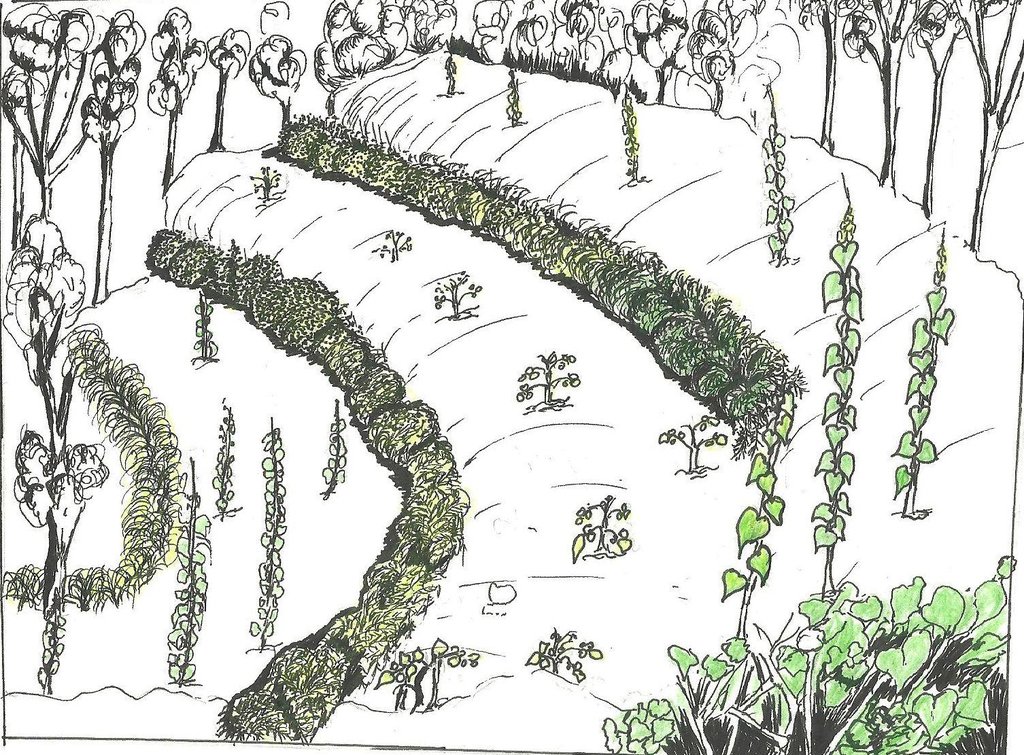Calliandra contour hedges [Uganda]
- Creación:
- Actualización:
- Compilador: Wilson Bamwerinde
- Editor: –
- Revisor: Alexandra Gavilano
Orugo rwa Calliandra (Rukiga)
technologies_1178 - Uganda
Visualizar secciones
Expandir todo Colapsar todos1. Información general
1.2 Detalles de contacto de las personas de referencia e instituciones involucradas en la evaluación y la documentación de la Tecnología
Nombre del proyecto que financió la documentación/ evaluación de la Tecnología (si fuera relevante)
The Transboundary Agro-ecosystem Management Project for the Kagera River Basin (GEF-FAO / Kagera TAMP )Nombre de la(s) institución(es) que facilitaron la documentación/ evaluación de la Tecnología (si fuera relevante)
Food and Agriculture Organization of the United Nations (FAO) - ItaliaNombre de la(s) institución(es) que facilitaron la documentación/ evaluación de la Tecnología (si fuera relevante)
Kabale District Local Government (Kabale District Local Government) - Uganda1.3 Condiciones referidas al uso de datos documentados mediante WOCAT
El compilador y la/s persona(s) de referencia claves aceptan las condiciones acerca del uso de los datos documentados mediante WOCAT:
Sí
2. Descripción de la Tecnología MST
2.1 Breve descripción de la Tecnología
Definición de la Tecnología:
Contour hedges of Calliandra planted on very steep slopes to combat soil erosion by decreasing surface runoff and increasing infiltration.
2.2 Descripción detallada de la Tecnología
Descripción:
Calliandra Calothyrsus trees are closely planted along the contours on hilly and steep slopes to create natural and effective barriers for reduction of the surface runoff and retention of eroded sediment. Calliandra hedge barriers are a fairly cheap, effective, and sustainable way of controlling soil erosion and landslides on vulnerable steep slopes, especially where trash lines and Napier grass strips were inadequate to mitigate dispersed and concentrated soil and water runoff. Once established, the living barrier is durable with minimal additional maintenance cost to the farmer apart from pruning. The average length of a hedgerow is 50 to 70 m, corresponding to the width of a single terrace. The height varies according to intended use of the mature shoots. To use the stems as stakes, the hedgerow is allowed to reach a height of 4 to 6 m at maturity while a height of 1 to 2 m is sufficient for harvesting foliage as livestock fodder. The hedge barrier reaches its mature, maintenance level after 12 to 18 months.
Purpose of the Technology: The main purpose of the Calliandra hedge barrier is to reduce soil and water runoff.Calliandra is a leguminous shrub with deep roots that provids additional benefits such as soil stabilization and soil fertility improvement through nitrogen fixing. Calliandra is a source of fodder and its flowers attract bees.
Establishment / maintenance activities and inputs: At the beginning of the rainy season, calliandra seedlings are transplanted from the nursery (0.2m to 0.3m height) and planted in a row (0.3m spacing). In the early stages, gap-filling with more seedlings may be necessary as some fail to get established. A mixture of top soil and manure is applied in the spaces between the seedlings and watering is done to improve the seedling survival rate. The distance between rows is 10 to 15 m and depends on the gradient of the slope. Establishment of hedges starts with construction of an earth banked terrace, creating a trench at the lower end of the terrace. Calliandra seedlings are planted on the higher side of the trench. Measuring off 10 m lengths upwards into the terrace, other rows of Calliandra seedlings are planted along the contour in order to achieve the inter-row spacing. Establishment is manual labor intensive and therefore the community, organized as Farmer Field Schools, participates in the planting, one field at a time. Simple tools such as hand hoes, sokajembe (pick-axe) and shovels are used. Maintenance is achieved by weeding, mulching and cutting back. For it to establish well, Calliandra needs to be weeded to minimize competition with weeds for water and nutrients . The weeds also harbour pests. It may also be necessary to mulch the area around each seedling during the dry season. Where mulching is done, the mulch is placed at least 0.05m away from the plant to reduce pest attacks. Calliandra calothyrsus trees are cut back at a height of 2m to between 0.15m and 1m to improve foliage which is used as fodder for livestock. The hedge is then maintained at a height of 1 to 6 m depending on the intended additional uses. The branches removed can be used as fuel wood or stakes, while leaves can be used as fodder.
Natural / human environment: The hedge barrier may be attacked by pests. Scales are white, powdery insects that attack Calliandra stems. Scales can be controlled using washing detergents such as ‘Omo’ dissolved in water and sprinkled on affected plants using leafy branches or a knapsack sprayer. Black ants can seriously damage trees. They can be controlled by spraying. Other likely pests are crickets and grass hoppers which affect seedlings in nurseries, and Armillaria mellea, a fungus that attacks roots of Calliandra plant causing root rot and eventual death. Affected plants are uprooted and burnt. In addition, calliandra is affected by hot, dry weather. During the hot, dry weather, the hedge barrier becomes weak. However during the wet season it sprouts again, and, if well managed, becomes healthy again. A well-maintained hedge barriers can last well over 20 years.
2.3 Fotografías de la Tecnología
2.5 País/ región/ lugares donde la Tecnología fue aplicada y que se hallan comprendidos por esta evaluación
País:
Uganda
Región/ Estado/ Provincia:
Uganda
Especifique más el lugar :
Kabale District
Comentarios:
Boundary points of the Technology area: -1.29294, 29.96006
-1.29336, 29.96027
-1.29327, 29.96084
Total area covered by the SLM Technology is 0.03 km2.
The documented case study area is around 3ha
-1.29371, 29.96095
-1.29345, 29.96091
Map
×2.6 Fecha de la implementación
Si no se conoce el año preciso, indique la fecha aproximada:
- hace menos de 10 años (recientemente)
2.7 Introducción de la Tecnología
Especifique cómo se introdujo la Tecnología:
- mediante proyectos/ intervenciones externas
Comentarios (tipo de proyecto, etc.):
The technology was introduced by ICRAF in 2006 and scaled-up Kagera TAMP project 2 years ago.
3. Clasificación de la Tecnología MST
3.2 Tipo(s) actuales de uso de la tierra donde se aplica la Tecnología

Tierras cultivadas
- Cosecha anual
- Cosecha de árboles y arbustos
Cosechas anuales - Especifique cultivos:
- cultivos para forraje - otros
- leguminosas y legumbres - frijoles
Cultivos de matorrales y arbustos - Especifique cultivos:
- árboles para forraje (Calliandra, Leucaena leucocephala, Prosopis, etc.)
Número de temporadas de cultivo por año:
- 2
Especifique:
Longest growing period in days: 120Longest growing period from month to month: February to MaySecond longest growing period in days: 90Second longest growing period from month to month: September to November

Tierra de pastoreo
Pastoreo intensivo/ producción de forraje:
- Pastoreo mejorado
- Livestock is grazing on crop residues
Comentarios:
Livestock density (if relevant):
1-10 LU /km2
Major land use problems (compiler’s opinion): The slopes are steep >30% to very steep >60%), with very high precipitation (>1440 mm). Severe surface erosion and landslides may occur at the beginning of the rains, before sufficient vegetation covers the soil. Continuous cultivation with little external inputs and nutrient transfer affects negatively soil fertility and in results reduces crops growth/vegetation cover, leading to erosion on steep slopes.
Major land use problems (land users’ perception): Floods are common in the valleys over the past ten years.
Improved pasture: Diary hiefers,pigs(largewhite and layers)pasture include calliandra,stellia and elephant grass.
Constraints of settlement / urban: floods invade houses
Constraints of infrastructure network (roads, railways, pipe lines, power lines): transport problem
3.4 Provisión de agua
Provisión de agua para la tierra donde se aplica la Tecnología:
- de secano
3.6 Medidas MST que componen la Tecnología

medidas vegetativas
- V1: Cubierta de árboles y arbustos
Comentarios:
Type of vegetative measures: aligned: -contour
3.7 Principales tipos de degradación de la tierra encarados con la Tecnología

erosión de suelos por agua
- Wt: pérdida de capa arable/ erosión de la superficie
- Wm: movimiento de masas / deslizamientos de tierra
Comentarios:
Main causes of degradation: soil management (Poor vegetative cover/no trees to bind soil particles.), Heavy / extreme rainfall (intensity/amounts) (Rainfall intensifying in september and April.), other natural causes (avalanches, volcanic eruptions, mud flows, highly susceptible natural resources, extreme topography, etc.) specify (steep slopes (extreme topography)), population pressure (Population increase/no of people increased per sq km), poverty / wealth (lack of resources to implement known natural resources degradation mitigation measures)
Secondary causes of degradation: education, access to knowledge and support services
3.8 Prevención, reducción o restauración de la degradación de la tierra
Especifique la meta de la Tecnología con relación a la degradación de la tierra:
- prevenir la degradación de la tierra
- reducir la degradación de la tierra
4. Especificaciones técnicas, actividades de implementación, insumos y costos
4.1 Dibujo técnico de la Tecnología
Especificaciones técnicas (relacionadas al dibujo técnico):
Calliandra trees are planted in rows along the contour. Cutting back is done between 12 and 18 months to a height of 0.5 m. The trees are allowed to grow to between 1 and 6 m and the hedge is maintained at that height. Gap-filling, weeding and trimming are critical for a productive hedge.
Location: Bukoora, Kabale. Kabale/Uganda
Technical knowledge required for field staff / advisors: moderate (Such knowledge as is required to manage the Calliandra nursery, transplant and maintain the plants especially until the first coppice.)
Technical knowledge required for land users: moderate (The land user is responsible for maintaining the technology on his or her land and a good hedge requires diligence)
Main technical functions: control of dispersed runoff: impede / retard, control of concentrated runoff: impede / retard, improvement of ground cover, improvement of topsoil structure (compaction), stabilisation of soil (eg by tree roots against land slides), increase in nutrient availability (supply, recycling,…)
Secondary technical functions: control of raindrop splash, reduction of slope angle, reduction of slope length, increase of infiltration, increase of groundwater level / recharge of groundwater, sediment retention / trapping, sediment harvesting, increase of biomass (quantity)
Aligned: -contour
Vegetative material: T : trees / shrubs
Number of plants per (ha): 670 to 720
Spacing between rows / strips / blocks (m): 10
Vertical interval within rows / strips / blocks (m): 0.4
Width within rows / strips / blocks (m): 0.7
Trees/ shrubs species: Calliandra was planted
Fruit trees / shrubs species: n/a
Perennial crops species: n/a
Grass species: n/a
Other species: n/a
Slope (which determines the spacing indicated above): 40%
If the original slope has changed as a result of the Technology, the slope today is (see figure below): n/a%
Gradient along the rows / strips: <3%
Autor:
Byonabye, Prossy, Kagera TAMP, Kabale, Uganda
Fecha:
2013-11-29
4.2 Información general sobre el cálculo de insumos y costos
otra / moneda nacional (especifique):
UGX
Si fuera relevante, indique la tasa de cambio de dólares americanos a la moneda local (ej. 1 U$ = 79.9 Reales Brasileros): 1 U$ =:
2602,0
Indique el costo promedio del salario de trabajo contratado por día:
3.80
4.3 Actividades de establecimiento
| Actividad | Momento (estación) | |
|---|---|---|
| 1. | Establishment of Calliandra nursery | Dry season |
| 2. | Plantation of Calliandra seedling on the higher side of the trench | Wet season |
| 3. | Weeding |
4.4 Costos e insumos necesarios para el establecimiento
| Especifique insumo | Unidad | Cantidad | Costos por unidad | Costos totales por insumo | % de los costos cubiertos por los usuarios de las tierras | |
|---|---|---|---|---|---|---|
| Mano de obra | Labour | 1,0 | 44,6 | 44,6 | 100,0 | |
| Equipo | tools | 1,0 | 16,2 | 16,2 | 100,0 | |
| Material para plantas | seedlings | 1,0 | 30,4 | 30,4 | 100,0 | |
| Material para plantas | seeds | 1,0 | 9,6 | 9,6 | 100,0 | |
| Costos totales para establecer la Tecnología | 100,8 | |||||
| Costos totales para establecer la Tecnología en USD | 0,04 | |||||
Comentarios:
Duration of establishment phase: 18 month(s)
4.5 Actividades de establecimiento/ recurrentes
| Actividad | Momento/ frequencia | |
|---|---|---|
| 1. | Prunning and triming the hedge barriers | wet/dry season |
4.6 Costos e insumos necesarios para actividades de mantenimiento/ recurrentes (por año)
| Especifique insumo | Unidad | Cantidad | Costos por unidad | Costos totales por insumo | % de los costos cubiertos por los usuarios de las tierras | |
|---|---|---|---|---|---|---|
| Mano de obra | labour | 1,0 | 20,8 | 20,8 | 100,0 | |
| Equipo | tools | 1,0 | 16,2 | 16,2 | 100,0 | |
| Material para plantas | seedlings | 1,0 | 1,0 | 1,0 | 100,0 | |
| Otros | 100,0 | |||||
| Indique los costos totales para mantenecer la Tecnología | 38,0 | |||||
| Costos totales para mantener la Tecnología en USD | 0,01 | |||||
Comentarios:
Machinery/ tools: I panga,1 watering can, 1hoe.
The cost assesment above refers to steep slopes.
4.7 Factores más determinantes que afectan los costos:
Describa los factores más determinantes que afectan los costos:
The cost of seedlings (0.20 US$ each) and their transport up along steep slopes are the key factors affecting costs and hindering spontaneous adoption of the technology. Otherwise, the technology is acceptable to farmers as benefits are easily visible in the short run.
5. Entorno natural y humano
5.1 Clima
Lluvia anual
- < 250 mm
- 251-500 mm
- 501-750 mm
- 751-1,000 mm
- 1,001-1,500 mm
- 1,501-2,000 mm
- 2,001-3,000 mm
- 3,001-4,000 mm
- > 4,000 mm
Zona agroclimática
- Sub-húmeda
Thermal climate class: tropics. at the Equator
5.2 Topografía
Pendientes en promedio:
- plana (0-2 %)
- ligera (3-5%)
- moderada (6-10%)
- ondulada (11-15%)
- accidentada (16-30%)
- empinada (31-60%)
- muy empinada (>60%)
Formaciones telúricas:
- meseta/ planicies
- cordilleras
- laderas montañosas
- laderas de cerro
- pies de monte
- fondo del valle
Zona altitudinal:
- 0-100 m s.n.m.
- 101-500 m s.n.m.
- 501-1,000 m s.n.m
- 1,001-1,500 m s.n.m
- 1,501-2,000 m s.n.m
- 2,001-2,500 m s.n.m
- 2,501-3,000 m s.n.m
- 3,001-4,000 m s.n.m
- > 4,000 m s.n.m
5.3 Suelos
Profundidad promedio del suelo:
- muy superficial (0-20 cm)
- superficial (21-50 cm)
- moderadamente profunda (51-80 cm)
- profunda (81-120 cm)
- muy profunda (>120 cm)
Textura del suelo (capa arable):
- áspera/ ligera (arenosa)
- mediana (limosa)
Materia orgánica de capa arable:
- media (1-3%)
- baja (<1%)
5.4 Disponibilidad y calidad de agua
Agua subterránea:
> 50 m
Disponibilidad de aguas superficiales:
pobre/ ninguna
5.5 Biodiversidad
Diversidad de especies:
- baja
5.6 Las características de los usuarios de la tierra que aplican la Tecnología
Orientación del mercado del sistema de producción:
- mixta (subsistencia/ comercial)
Ingresos no agrarios:
- menos del 10% de todos los ingresos
Nivel relativo de riqueza:
- pobre
- promedio
Individuos o grupos:
- individual/ doméstico
Nivel de mecanización:
- trabajo manual
Género:
- mujeres
- hombres
Indique otras características relevantes de los usuarios de las tierras:
Difference in the involvement of women and men: Maintenance such as pruning trimming is mostly done by the men, but the other activities are done by both men and women.
Population density: 200-500 persons/km2
Annual population growth: 2% - 3%; 3%
5% of the land users are rich and own 40% of the land.
30% of the land users are average wealthy and own 30% of the land (meets basic needs/necesities).
45% of the land users are poor and own 20% of the land.
20% of the land users are poor and own 10% of the land.
Off-farm income specification: Crop and animal production greatly increased for land users implementing conservation measures , compared to those who do not implement.
5.7 Área promedio de la tierra usada por usuarios de tierra que aplican la Tecnología
- < 0.5 ha
- 0.5-1 ha
- 1-2 ha
- 2-5 ha
- 5-15 ha
- 15-50 ha
- 50-100 ha
- 100-500 ha
- 500-1,000 ha
- 1,000-10,000 ha
- > 10,000 ha
¿Esto se considera de pequeña, mediana o gran escala (refiriéndose al contexto local)?
- pequeña escala
5.8 Tenencia de tierra, uso de tierra y derechos de uso de agua
Tenencia de tierra:
- individual, sin título
Derechos de uso de tierra:
- individual
Comentarios:
The land belongs to an individual with no title but has all the rights over it.
5.9 Acceso a servicios e infraestructura
salud:
- pobre
- moderado
- bueno
educación:
- pobre
- moderado
- bueno
asistencia técnica:
- pobre
- moderado
- bueno
mercados:
- pobre
- moderado
- bueno
energía:
- pobre
- moderado
- bueno
caminos y transporte:
- pobre
- moderado
- bueno
agua potable y saneamiento:
- pobre
- moderado
- bueno
servicios financieros:
- pobre
- moderado
- bueno
n/an/an/an/a:
- pobre
- moderado
- bueno
6. Impactos y comentarios para concluir
6.1 Impactos in situ demostrados por la Tecnología
Impactos socioeconómicos
Producción
producción de cultivo
Cantidad antes de MST:
150
Cantidad luego de MST:
700
calidad de forraje
Cantidad antes de MST:
-
Cantidad luego de MST:
-
producción animal
Cantidad antes de MST:
-
Cantidad luego de MST:
25
área de producción
Ingreso y costos
ingreso agrario
Cantidad antes de MST:
1.5 million
Cantidad luego de MST:
3.5million
Impactos socioculturales
seguridad alimentaria/ autosuficiencia
MST/ conocimiento de la degradación de la tierra
Cantidad antes de MST:
-
Cantidad luego de MST:
-
mitigación de conflicto
Impactos ecológicos
Ciclo de agua/ escurrimiento de sedimento
escurrimiento superficial
Suelo
humedad del suelo
cubierta del suelo
pérdida de suelo
ciclo/ recarga de nutrientes
Biodiversidad: vegetación, animales
biomasa/ sobre suelo C
diversidad vegetal
Otros impactos ecológicos
increased pests
6.2 Impactos fuera del sitio demostrados por la Tecnología
inundaciones río abajo
colmatación río abajo
daño a campos de vecinos
Cantidad antes de MST:
-
Cantidad luego de MST:
-
daños a infraestructura pública / privada
Cantidad antes de MST:
-
Cantidad luego de MST:
-
6.3 Exposición y sensibilidad de la Tecnología al cambio climático gradual y a extremos relacionados al clima/ desastres (desde la percepción de los usuarios de tierras)
Cambio climático gradual
Cambio climático gradual
| Estación | Incremento o reducción | ¿Cómo es que la tecnología soporta esto? | |
|---|---|---|---|
| temperatura anual | incrementó | bien |
Extremos (desastres) relacionados al clima
Desastres climatológicos:
| ¿Cómo es que la tecnología soporta esto? | |
|---|---|
| tormenta de lluvia local | bien |
Desastres climatológicos
| ¿Cómo es que la tecnología soporta esto? | |
|---|---|
| sequía | bien |
Desastres hidrológicos
| ¿Cómo es que la tecnología soporta esto? | |
|---|---|
| inundación general (río) | bien |
Otras consecuencias relacionadas al clima
Otras consecuencias relacionadas al clima
| ¿Cómo es que la tecnología soporta esto? | |
|---|---|
| periodo reducido de crecimiento | no se sabe |
| n/a |
6.4 Análisis costo-beneficio
¿Cómo se comparan los beneficios con los costos de establecimiento (desde la perspectiva de los usuarios de tierra)?
Ingresos a corto plazo:
negativo
Ingresos a largo plazo:
muy positivo
¿Cómo se comparan los beneficios con los costos de mantenimiento/ recurrentes (desde la perspectiva de los usuarios de tierra)?
Ingresos a corto plazo:
negativo
Ingresos a largo plazo:
positivo
Comentarios:
Benefits are high compared to establishment and maintenance cost
6.5 Adopción de la Tecnología
Comentarios:
88% of land user families have adopted the Technology with external material support
45 land user families have adopted the Technology with external material support
12% of land user families have adopted the Technology without any external material support
6 land user families have adopted the Technology without any external material support
There is a moderate trend towards spontaneous adoption of the Technology
Comments on adoption trend: The technology is appreciated by most farmers but adoption is limited by cost of seedlings and transportation up steep slopes
6.7 Fuerzas/ ventajas/ oportunidades de la Tecnología
| Fuerzas/ ventajas/ oportunidades desde la perspectiva del usuario de la tierra |
|---|
|
Calliandra binds the soil, thus reduces landslides. How can they be sustained / enhanced? It should be maintained through proper management |
|
Adds scenic beauty on a plot How can they be sustained / enhanced? By regular trimming |
|
Calliandra is good and attractive to bees How can they be sustained / enhanced? Leave every second or third row to flower |
| Fuerzas/ ventajas/ oportunidades desde la perspectiva del compilador o de otra persona de referencia clave |
|---|
|
It is easy to establish and maintain How can they be sustained / enhanced? Promote education campaign and spread information |
|
It has helped to increase crop and animal production How can they be sustained / enhanced? By proper management and not overgrazing animals |
|
Stabilize the soil and strenghtening resistance to intensive rainfall and fast runoff How can they be sustained / enhanced? Promote technology through increased community mobilization |
|
Very effective to reduce soil erosion How can they be sustained / enhanced? Combine with other practicies e.g. mulching |
6.8 Debilidades/ desventajas/ riesgos de la Tecnología y formas de sobreponerse a ellos
| Debilidades/ desventajas/ riesgos desde la perspectiva del compilador o de otra persona de referencia clave | ¿Cómo sobreponerse a ellas? |
|---|---|
| The hedge barrier is ineffective before 12 months | Combine with trash lines before establishment |
| Technology harbors nesting birds | Ensure regular trimming of Calliandra to reasonable height and use scarecrows |
| Needs at least 2 seasons to establish | Apply manure and water to the seedlings to ensure accelerated growth |
| May reduce the amount of sunlight available to young crops if left untrimmed | Trim regularly |
| Extra cost in protecting from damage by livestock | Inter-crop with other fodder species to act as alternative fodder for livestock |
7. Referencias y vínculos
7.1 Métodos/ fuentes de información
7.2 Vínculos a las publicaciones disponibles
Título, autor, año, ISBN:
Kagera TAMP Project website
¿Dónde se halla disponible? ¿Costo?
http://www.fao.org/nr/kagera/en/
Vínculos y módulos
Expandir todo Colapsar todosVínculos
No hay vínculos
Módulos
No se hallaron módulos


